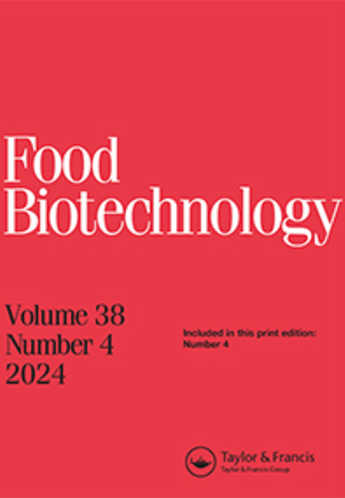Evaluation of antibacterial potential of biosurfactant produced by surfactin-producing Bacillus isolated from selected Malaysian fermented foods
IF 1.6
4区 农林科学
Q4 BIOTECHNOLOGY & APPLIED MICROBIOLOGY
引用次数: 18
Abstract
ABSTRACT Biosurfactants or microbial surfactants are structurally diverse and contribute to reducing surface and interfacial tension. Apart from being isolated from municipal waste and oil contaminated soil, biosurfactant-producing Bacillus spp. can also be found in fermented foods. Bacillus subtilis produce surfactant, which exhibits antibacterial activity against various pathogenic bacteria. In this study, surfactant-producing Bacillus were isolated from traditional fermented food namely; budu (fish sauce), cincalok (fermented small shrimps), tempeh (fermented soybeans) and tapai ubi kayu (fermented cassava). Identification of surfactin-producing bacteria was conducted using 16S rRNA which indicated that surfactin-producing strains isolated from budu and tempeh are Bacillus subtilis while strains from cincalok and tapai ubi kayu are Bacillus amyloliquefaciens with a sequence similarity of 99%. Characterization of surfactin was carried out by High-Performance Liquid Chromatography (HPLC) and Liquid Chromatography-Mass Spectrometry (LCMS). HLPC analyzes identified major peaks contributing to the presence of surfactin. LCMS analysis detected specific mass to charge ratio (m/z) which contributed to the presence of maximum thirteen surfactin isoforms. Surfactin produced by the isolated strains also exhibited antibacterial activity toward pathogenic bacteria, namely Bacillus cereus, Listeria monocytogenes, Staphylococcus aureus, Streptococcus pneumoniae, Salmonella Typhimurium, Serratia marcescens and Klebsiella pneumoniae. All isolated strains from the Malaysian fermented food types investigated in this study were able to produce surfactin. In addition, antibacterial screening via agar well diffusion, measurements of MBC and MIC show surfactin produced by the isolated strains have antibacterial activities toward certain Gram-positive and Gram-negative bacteria tested in this study.从马来西亚发酵食品中分离的表面活性素产生芽孢杆菌产生的生物表面活性剂的抗菌潜力评估
摘要生物表面活性剂或微生物表面活性剂结构多样,有助于降低表面和界面张力。除了从城市垃圾和石油污染的土壤中分离出来外,在发酵食品中也可以发现产生生物表面活性剂的芽孢杆菌。枯草芽孢杆菌产生表面活性剂,对各种致病菌具有抗菌活性。本研究从传统发酵食品中分离得到表面活性剂产生芽孢杆菌;budu(鱼露)、cincalok(发酵小虾)、tempeh(发酵大豆)和tapai ubi kayu(发酵木薯)。利用16S rRNA对产表面活性素的细菌进行了鉴定,结果表明,从budu和tempeh分离的产表面活性蛋白的菌株为枯草芽孢杆菌,而从cincalok和tapai ubi-kayu分离的菌株为解淀粉芽孢杆菌,序列相似性为99%。采用高效液相色谱法(HPLC)和液相色谱-质谱法(LCMS)对表面活性素进行了表征。HLPC分析鉴定的对表面活性素的存在有贡献的主峰。LCMS分析检测到比质荷比(m/z),这有助于存在最多13种表面活性素异构体。分离菌株产生的表面活性素对致病菌也表现出抗菌活性,即蜡样芽孢杆菌、单核细胞增多性李斯特菌、金黄色葡萄球菌、肺炎链球菌、鼠伤寒沙门氏菌、粘质沙雷氏菌和肺炎克雷伯菌。本研究中调查的所有来自马来西亚发酵食品类型的分离菌株都能产生表面活性素。此外,通过琼脂扩散进行抗菌筛选,MBC和MIC的测量表明,分离菌株产生的表面活性素对本研究中测试的某些革兰氏阳性菌和革兰氏阴性菌具有抗菌活性。
本文章由计算机程序翻译,如有差异,请以英文原文为准。
求助全文
约1分钟内获得全文
求助全文
来源期刊

Food Biotechnology
工程技术-生物工程与应用微生物
CiteScore
3.80
自引率
0.00%
发文量
15
审稿时长
>12 weeks
期刊介绍:
Food Biotechnology is an international, peer-reviewed journal that is focused on current and emerging developments and applications of modern genetics, enzymatic, metabolic and systems-based biochemical processes in food and food-related biological systems. The goal is to help produce and improve foods, food ingredients, and functional foods at the processing stage and beyond agricultural production.
Other areas of strong interest are microbial and fermentation-based metabolic processing to improve foods, food microbiomes for health, metabolic basis for food ingredients with health benefits, molecular and metabolic approaches to functional foods, and biochemical processes for food waste remediation. In addition, articles addressing the topics of modern molecular, metabolic and biochemical approaches to improving food safety and quality are also published.
Researchers in agriculture, food science and nutrition, including food and biotechnology consultants around the world will benefit from the research published in Food Biotechnology. The published research and reviews can be utilized to further educational and research programs and may also be applied to food quality and value added processing challenges, which are continuously evolving and expanding based upon the peer reviewed research conducted and published in the journal.
 求助内容:
求助内容: 应助结果提醒方式:
应助结果提醒方式:


